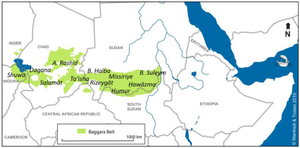Messiria tribe
This article needs additional citations for verification. (November 2008) |

The Messiria (
Geography of Messiria Country (Dar Al Messiria)
The term Dar means land or location. The word Al or al and sometimes El or el corresponds to the definite article The in English. The term Dar Al Messiria means the land or location of the Messiria. According to Ian Cunnison 1966,
In general the Dar Al Messiria or their zones can be divided into three areas:
1.1. Dar Al Messiria in Kordofan, Sudan.
1.2. Dar Al Messiria in Darfur, Sudan.
1.3. Dar Al Messiria in Chad.
The Messiria in the three different zones have been separated for so long that they have developed localized cultural and social differences. The Messiria in
Dar Al Messiria in Kordofan, Sudan
In Kordofan, the Messiria occupies the area historically known as West Kordofan, among their well known locations are: Abyei, Babanousa, El Muglad, Lagawa, El Mairam, and Lake Kailak.
Messiria Divisions in Kordofan
The main divisions of Messiria in
The Messiria Humr pastoralists migrate across the four regions of their homeland ("Dar el Humr“): Babanusa, Muglad, Goz and Bahr el Arab.[5]
- Messiria Zurug – According to MacMichael, 1967[4] the Messiria Zurug have the following divisions:
Still there subtribal divisions with each subtribes.
- Humrare divided into:
Dar Al Messiria in Darfur, Sudan
The area known as Nitega (نتيقة) is the mainland of the Messiria in
Second Sudanese Civil War: 1983–2005
Background of the conflict
The Misseriyya mostly live around
The location of Messiria of
Historical grazing disputes
During the dry season the Misseriya migrate to the river Kiir in Abyei. They call the region the Bahr Al Arab.[7]
Both branches of Messiria, the Humr and the Zurug, are involved in historical grazing disputes and isolated fights along their southern borders, either with
Such targeting of
In Abyei the Dinka Ngok and Misseryia are engaged in territorial disputes.[10]
The Civil War
This section needs expansion. You can help by adding to it. (November 2008) |
See the Civil War under
The Sudanese government gave the Misseriya Arab militia machine guns and ordered them to drive the Nilotic peoples from the Western Upper Nile oil region. They successfully took the Luk Nuer in Bentiu and Eastern Jikany Nuer in 1984.[11][12]
References
- ^ Adam, Biraima M. 2012. Baggara of Sudan: Culture and Environment, Amazon online Books. Baggara of Sudan: Culture and Environment
- ^ a b Ian Cunnison, 1966, Baggara Arabs, Power and the lineage in a Sudanese Nomad Tribe, Clarendon Press, Oxford, pages: 1–3
- ISBN 978-0-300-16273-8
- ^ ISBN 978-0-7146-1113-6, 260 pages.
- ISBN 90-04-06404-4.
- ^ Flint, J. and Alex de Waal, 2008 (2nd Edn), Darfur: A new History of a Long War, Zed Books.
- ISBN 978-1-56432-364-4. Retrieved 9 January 2011.
- ISBN 9780300162738
- Richard Crockett2010.Yale University Press Sudan Darfur and the Failure of an African State p. 45 (also spelled Anya-Nya, a term for snake poison)ISBN 9780300162738
- ^ Al Jazeera (5 January 2011). "Tribal trouble in Sudan". ALJAZEERA. Retrieved 7 January 2011.
- ISBN 1-56432-193-2. Retrieved 9 January 2011.
- Richard Crockett2010.Yale University Press Sudan Darfur and the Failure of an African StateISBN 9780300162738
